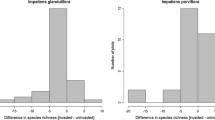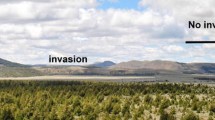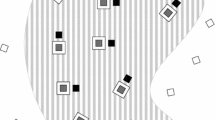Abstract
The genus Impatiens (Balsaminaceae) includes three widespread species in the Czech Republic, central Europe: the native I. noli-tangere, and two invasive species, I. parviflora and I. glandulifera, differing in the dynamics of invasion. They all occur in similar habitats and share basic life-history characteristics, which make them a suitable model for studying species traits associated with invasiveness. In this study we investigated differences in habitat requirements of these Impatiens species, their coexistence and short-term population dynamics in the field. We established 84 1 × 1 m permanent plots in five localities where all three species co-occurred. In each plot vascular plant species were determined, their cover estimated and all individuals of Impatiens species counted. Site characteristics including tree canopy cover, soil moisture, nitrogen and carbon content, and slope were measured directly. Nutrients, light, humidity and soil reaction were estimated using Ellenberg indicator values. The presence of I. noli-tangere was strongly correlated with high soil moisture, that of I. parviflora with high tree canopy cover and low soil moisture. Impatiens glandulifera exhibited a unimodal response to tree canopy cover, avoiding both very shaded and fully open sites. The current-year abundances of all species were negatively related to those of congeneric species. These results suggest that the coexistence of Impatiens species in the same habitat is due to microsite differentiation. Further spread of I. glandulifera to new habitats, and reduction of the native I. noli-tangere niche, can be expected in areas where the latter species co-occurs with competitively strong invasive congeners.



Similar content being viewed by others
References
Adamowski W (2008) Balsams on the offensive: the role of planting in the invasion of Impatiens species. In: Tokarska-Guzik B, Brock JH, Brundu G, Child L, Daehler CC, Pyšek P (eds) Plant invasions: human perception, ecological impacts and management. Backhuys Publishers, Leiden, pp 57–70
Andrews M, Maule HG, Hodge S, Cherrill A, Raven JA (2009) Seed dormancy, nitrogen nutrition and shade acclimation of Impatiens glandulifera: implications for successful invasion of deciduous woodland. Plant Ecol Divers 2:145–153
Baker HG (1965) Characteristics and modes of origin of weeds. In: Baker HG, Stebbins GL (eds) The genetics of colonizing species. Academic Press, New York, pp 147–172
Beerling DJ, Perrins DM (1993) Biological flora of British Isles: Impatiens glandulifera Royle (Impatiens Roylei Walp.). J Ecol 81:367–381
Berg MP, Ellers J (2010) Trait plasticity in species interactions: a driving force of community dynamics. Evol Ecol 24:617–629
Blumenthal D, Mitchell CE, Pyšek P, Jarošík V (2009) Synergy between pathogen release and resource availability in plant invasion. Proc Natl Acad Sci USA 106:7899–7904
Burns JH (2004) A comparison of invasive and non-invasive dayflower (Commelinaceae) across experimental nutrient and water gradients. Divers Distrib 10:387–397
Cavender-Bares J, Kozak KH, Fine PVA, Kembel SV (2009) The merging of community ecology and phylogenetic biology. Ecol Lett 12:693–715
Chittka L, Schürkens S (2001) Successful invasion of a floral market—an exotic Asian plant has moved in on Europe’s river-banks by bribing pollinators. Nature 411:653
Chmura D, Sierka E (2007) The invasibility of deciduous forest communities after disturbance: a case study of Carex brizoides and Impatiens parviflora invasion. For Ecol Manage 242:487–495
Chytrý M, Jarošík V, Pyšek P, Hájek O, Knollová I, Tichý L, Danihelka J (2008a) Separating habitat invasibility by alien plants from the actual level of invasion. Ecology 89:1541–1553
Chytrý M, Maskell LC, Pino J, Pyšek P, Vilà M, Font X, Smart SM (2008b) Habitat invasions by alien plants: a quantitative comparison among Mediterranean, subcontinental and oceanic regions of Europe. J Appl Ecol 45:448–458
Clements DR, Feenstra KR, Jones K, Staniforth R (2008) The biology of invasive alien plants in Canada. 9. Impatiens glandulifera Royle. Can J Plant Sci 88:403–417
Coombe DE (1956) Impatiens Parviflora DC. J Ecol 44:701–713
Crawley MJ (2008) The R book. Wiley, Chichester
Daehler CC (2001) Darwin’s naturalization hypothesis revisited. Am Nat 158:324–330
Darwin C (1859) The origin of species. John Murray, London
Daumann E (1967) Zur Bestäubungs- und Verbreitungsökologie dreier Impatiens-Arten. Preslia 39:43–58
Davis MA, Grime JP, Thompson K (2000) Fluctuating resources in plant communities: a general theory of invasibility. J Ecol 88:528–534
Dayan T, Simberloff D (2005) Ecological and community-wide character displacement: the next generation. Ecol Lett 8:875–894
Development Core Team R (2011) R: a language and environment for statistical computing, Version 2.12.2. R Foundation for Statistical Computing, Vienna
Donohue K, Pyle EH, Messiqua D, Heschel MS, Schmitt J (2001) Adaptive divergence in plasticity in natural populations of Impatiens capensis and its consequences for performance in novel habitats. Evolution 55:692–702
Dostál P, Weiser M, Koubek T (2012) Native jewelweed, but not other native species, displays post-invasion trait divergence. Oikos 121:1849–1859
Dudley SA, Schmitt J (1995) Genetic differentiation in morphological responses to simulated foliage shade between populations of Impatiens capensis from open and woodland sites. Funct Ecol 9:655–666
Ehrenberger F, Gorbach S (1973) Methoden der organischen Elementar- und Spurenanalyse. Verlag Chemie, Weinheim
Ellenberg H, Weber HE, Düll R, Wirth V, Werner W, Paulissen D (1992) Zeigerwerte von Pflanzen in Mitteleuropa. Scr Geobot 18:1–258
Faliński JB (1998) Invasive alien plants, vegetation dynamics and neophytism. Phytocoenosis 10 (N.S.). Suppl Cartogr Geobot 9:163–188
Foxcroft LC, Rouget M, Richardson DM (2007) Risk assessment of riparian plant invasions into protected areas. Conserv Biol 21:412–421
Foxcroft LC, Jarošík V, Pyšek P, Richardson DM, Rouget M (2011) Protected-area boundaries as filters of plant invasions. Conserv Biol 25:400–405
Franks PJ, Farquhar GD (1999) A relationship between humidity response, growth form and photosynthetic operating point in C-3 plants. Plant Cell Environ 22:1337–1349
Frazer GW, Canham CD, Lertzman KP (1999) Gap Light Analyzer (GLA): users manual and program documentation. Simon Frazer University, Burnaby, British Columbia, and the Institute of Ecosystem Studies, Millbrook, New York
Gaertner M, Richardson DM, Privett SDJ (2011) Effects of alien plants on ecosystem structure and functioning and implications for restoration: insights from three degraded sites in South African Fynbos. Environ Manag 48:57–69
Godefroid S, Dana ED (2007) Can Ellenberg’s indicator values for Mediterranean plants be used outside their region of definition? J Biogeogr 34:62–68
Godefroid S, Koedam N (2010) Comparative ecology and coexistence of introduced and native congeneric forest herbs: Impatiens parviflora and Impatiens noli-tangere. Plant Ecol Evol 143:119–127
Green EK, Galatowitsch SM (2002) Effects of Phalaris arundinacea and nitrate-N addition on the establishment of wetland plant communities. J Appl Ecol 39:134–144
Grotkopp E, Rejmánek M (2007) High seedling relative growth rate and specific leaf area are traits of invasive species: phylogenetically independent contrasts of woody angiosperms. Am Nat 94:526–532
Guevara-Escobar A, Tellez J, Gondalez-Sosa E (2005) Use of digital photography for analysis of canopy closure. Agrofor Syst 65:175–185
Hatcher PE (2003) Impatiens noli-tangere L. J Ecol 91:147–167
Hejda M (2012) What Is the impact of Impatiens parviflora on diversity and composition of herbal layer communities of temperate forests? PLoS One 7(6):e39571. doi:10.1371/journal.pone.0039571
Hejda M, Pyšek P (2006) What is the impact of Impatiens glandulifera on species diversity of invaded riparian vegetation? Biol Conserv 132:143–152
Hejda M, Pyšek P, Jarošík V (2009a) Impact of invasive plants on the species richness, diversity and composition of invaded communities. J Ecol 97:393–403
Hejda M, Pyšek P, Pergl J, Sádlo J, Chytrý M, Jarošík V (2009b) Invasion success of alien plants: do habitats affinities in the native distribution range matter? Glob Ecol Biogeogr 18:372–382
Heschel MS, Donohue K, Hausman N, Schmitt J (2002) Population differentiation and natural election for water-use efficiency in Impatiens capensis (Balsaminaceae). Int J Plant Sci 163:907–912
Holdredge C, Bertness MD, Von Wettberg E, Silliman BR (2010) Nutrient enrichment enhances hidden differences in phenotype to drive a cryptic plant invasion. Oikos 119:1776–1784
Hulme PE, Bremner ET (2005) Assessing the impact of Impatiens glandulifera on riparian habitats: partitioning diversity components following species removal. J Appl Ecol 43:43–50
Huston MA, Deangelis DL (1994) Competition and coexistence—the effect of resource transport and supply rates. Am Nat 144:954–977
Käfer J, Witte JPM (2004) Cover-weighted averaging of indicator values in vegetation analyses. J Veg Sci 15:647–652
Kubát K, Hrouda L, Chrtek J Jr, Kaplan Z, Kirschner J, Štěpánek J (eds) (2002) Key to the flora of the Czech Republic. Academia, Praha (in Czech)
Lambdon PW, Pyšek P, Basnou C, Hejda M, Arianoutsou M, Essl F, Jarošík V, Pergl J, Winter M, Anastasiu P, Andriopoulos P, Bazos I, Brundu G, Celesti-Grapow L, Chassot P, Delipetrou P, Josefsson M, Kark S, Klotz S, Kokkoris Y, Kühn I, Marchante H, Perglová I, Pino J, Vilà M, Zikos A, Roy D, Hulme PE (2008) Alien flora of Europe: species diversity, temporal trends, geographical patterns and research needs. Preslia 80:101–149
Lhotská M, Kopecký K (1966) Zur Verbreitungsbiologie und Phytozönologie von Impatiens glandulifera Royle an den Flussystemen der Svitava, Svratka und oberen Odra. Preslia 38:376–385
MacDougall AS, Gilbert B, Levine JM (2009) Plant invasions and the niche. J Ecol 97:609–615
Mack RN, Simberloff D, Lonsdale WM, Evans H, Clout M, Bazzaz FA (2000) Biotic invasions: causes, epidemiology, global consequences, and control. Ecol Appl 10:689–710
Maherali H, Klironomos JN (2007) Influence of phylogeny on fungal community assembly and ecosystem functioning. Science 316:1746–1748
Malíková L, Prach K (2010) Spread of alien Impatiens glandulifera along rivers invaded at different times. Ecohydrol Hydrobiol 10:81–85
Maule HG, Andrews M, Watson C, Cherrill A (2000) Distribution, biomass and effect on native species of Impatiens glandulifera in a deciduous woodland in northeast England. Aspects Appl Biol 58:31–38
Molina-Montenegro MA, Penuelas J, Munne-Bosch S (2012) Higher plasticity in ecophysiological traits enhances the performance and invasion success of Taraxacum officinale (dandelion) in alpine environments. Biol Invasions 14:21–33
Moravcová L, Pyšek P, Jarošík V, Havlíčková V, Zákravský P (2010) Reproductive characteristics of neophytes in the Czech Republic: traits of invasive and non-invasive species. Preslia 82:365–390
Morgan DC, Smith H (1979) A systematic relationship between phytochrome-controlled development and species habitat, for plants grown in simulated natural radiation. Planta 145:253–258
Morris EC, Myerscough PJ (1991) Self-thinning and competition intensity over a gradient of nutrient availability. J Ecol 79:903–923
Nagelkerke NJD (1991) A note on a general definition of the coefficient of determination. Biometrika 78:691–692
Nobis M (2005) SideLook 1.1: imaging software for the analysis of vegetation structure with true-colour photographs. http://www.appleco.ch. Accessed 30 Jan 2013
Obidziński T, Symonides E (2000) The influence of the groundlayer structure on the invasion of small balsam (Impatiens parviflora DC.) to natural and degraded forests. Acta Soc Pol Bot 69:311–318
Perglová I, Pergl J, Skálová H, Moravcová L, Jarošík V, Pyšek P (2009) Differences in germination and seedling establishment of alien and native Impatiens species. Preslia 81:357–375
Pigliucci M (2005) Evolution of phenotypic plasticity: where are we going now? Trends Ecol Evol 20:481–486
Pyšek P, Prach K (1995) Invasion dynamics of Impatiens glandulifera—a century of spreading reconstructed. Biol Conserv 74:41–48
Pyšek P, Richardson DM (2007) Traits associated with invasiveness in alien plants: where do we stand? In: Nentwig W (ed) Biological invasions. Springer, Berlin, pp 97–125
Pyšek P, Richardson DM (2010) Invasive species, environmental change and management, and health. Ann Rev Environ Res 35:25–55
Pyšek P, Bacher S, Chytrý M, Jarošík V, Wild J, Celesti-Grapow L, Gassó N, Kenis M, Lambdon PW, Nentwig W, Pergl J, Roques A, Sádlo J, Solarz W, Vilà M, Hulme PE (2010) Contrasting patterns in the invasions of European terrestrial and freshwater habitats by alien plants, insects and vertebrates. Glob Ecol Biogeogr 19:317–331
Pyšek P, Chytrý M, Pergl J, Sádlo J, Wild J (2012a) Plant invasions in the Czech Republic: current state, introduction dynamics, invasive species and invaded habitats. Preslia 84:575–629
Pyšek P, Danihelka J, Sádlo J, Chrtek J Jr, Chytrý M, Jarošík V, Kaplan Z, Krahulec F, Moravcová L, Pergl J, Štajerová K, Tichý L (2012b) Catalogue of alien plants of the Czech Republic (2nd edition): checklist update, taxonomic diversity and invasion patterns. Preslia 84:155–255
Rejmánek M (1996) A theory of seed plant invasiveness: the first sketch. Biol Conserv 78:171–181
Richards CL, Bossdorf O, Muth NZ, Gurevitch J, Pigliucci M (2006) Jack of all trades, master of some? On the role of phenotypic plasticity in plant invasions. Ecol Lett 9:981–993
Richardson DM, Holmes PM, Esler KJ, Galatowitsch SM, Stromberg JC, Kirkman SP, Pyšek P, Hobbs RJ (2007) Riparian vegetation: degradation, alien plant invasions, and restoration prospects. Divers Distrib 13:126–139
Richardson PJ, MacDougall AS, Stanley AG, Kaye TN, Dunwiddie PW (2012) Inversion of plant dominance–diversity relationships along a latitudinal stress gradient. Ecology 93:1431–1438
Roy J (1990) In search of the characteristics of plant invaders. In: di Castri F et al (eds) Biological invasions in Europe and the Mediterranean Basin. Kluwer Academic Publishers, Dordrecht, pp 333–352
Sádlo J, Chytrý M, Pyšek P (2007) Regional species pools of vascular plants in habitats of the Czech Republic. Preslia 79:303–321
Shea K, Chesson P (2002) Community ecology theory as a framework for biological invasions. Trends Ecol Evol 17:170–176
Shmida A, Ellner S (1984) Coexistence of plant species with similar niches. Vegetatio 58:29–55
Skálová H, Pyšek P (2009) Germination and establishment of invasive and native Impatiens species in species-specific microsites. Neobiota 8:101–109
Skálová H, Moravcová L, Pyšek P (2011) Germination dynamics and seedling frost resistance of invasive and native Impatiens species reflect local climatic conditions. Perspect Plant Ecol 13:173–180
Skálová H, Havlíčková V, Pyšek P (2012) Seedling traits, plasticity and local differentiation as strategies of invasive species of Impatiens in central Europe. Ann Bot 110:1429–1438
Skálová H, Jarošík V, Dvořáčková Š, Pyšek P (2013) Effect of intra- and interspecific competition on the performance of native and invasive species of Impatiens under varying levels of shade and moisture. PLoS One 8(5):e62842. doi:10.1371/journal.pone.0062842
Slavík B (1996) The genus Impatiens in the Czech Republic. Preslia 67:193–211 (in Czech)
Smart SM, Scott WA (2004) Bias in Ellenberg indicator values—problems with detection of the effect of vegetation type. J Veg Sci 15:843–846
Suding KN, LeJeune KD, Seastedt TR (2004) Competitive impacts and response of an invasive weed: dependencies on nitrogen and phosphorus availability. Oecologia 141:526–535
ter Braak CJF, Šmilauer P (2002) CANOCO reference manual and CanoDraw for windows user’s guide: software for canonical community ordination (version 4.5). Microcomputer Power, New York
Thompson K, Hodgson JG, Grime JP, Rorison IH, Band SR, Spencer RE (1993) Ellenberg numbers revisited. Phytocoenologia 23:277–289
Tichý J (1997) Changes in forest vegetation on Ondřejník permanent plot after thirty years. Lesnictví 43:363–373 (in Czech)
Tichý L (2002) JUICE, software for vegetation classification. J Veg Sci 13:451–453
Tichý L, Hájek M, Zelený D (2010) Imputation of environmental variables for vegetation plots based on compositional similarity. J Veg Sci 21:88–95
Tilman D (1982) Resource competition and community structure. Princeton University Press, Princeton
Tolasz R (ed) (2007) Atlas of climate of the Czech Republic. Český hydrometeorologický ústav, Praha (in Czech)
van Kleunen M, Weber E, Fischer M (2010) A meta-analysis of trait differences between invasive and non-invasive plant species. Ecol Lett 13:235–245
Vervoort A, Jacquemart AL (2012) Habitat overlap of the invasive Impatiens parviflora DC with its native congener I. noli-tangere L. Phytocoenologia 42:249–257
Vervoort A, Cawoy V, Jacquemart AL (2011) Comparative reproductive biology in co-occurring invasive and native Impatiens species. Int J Plant Sci 172:366
Vilà M, Basnou C, Pyšek P, Josefsson M, Genovesi P, Gollasch S, Nentwig W, Olenin S, Roques A, Roy D, Hulme PE, DAISIE Partners (2010) How well do we understand the impacts of alien species on ecosystem services? A pan-European, cross-taxa assessment. Front Ecol Environ 8:135–144
Vilà M, Espinar JL, Hejda M, Hulme PE, Jarošík V, Maron JL, Pergl J, Schaffner U, Sun Y, Pyšek P (2011) Ecological impacts of invasive alien plants: a meta-analysis of their effects on species, communities and ecosystems. Ecol Lett 14:702–708
Vinton MA, Goergen EM (2006) Plant-soil feedbacks contribute to the persistence of Bromus inermis in tallgrass prairie. Ecosystems 9:967–976
Vitousek PM, Walker LR (1989) Biological invasion by Myrica faya in Hawai: plant demography, nitrogen fixation, ecosystem effects. Ecol Monogr 59:247–265
VivianSmith G (1997) Microtopographic heterogeneity and floristic diversity in experimental wetland communities. J Ecol 85:71–82
Vrchotová N, Šerá B, Krejčová J (2011) Allelopathic activity of extracts from Impatiens species. Plant Soil Environ 57:57–60
Williamson M, Pyšek P, Jarošík V, Prach K (2005) On the rates and patterns of spread of alien plants in the Czech Republic, Britain and Ireland. Écoscience 12:424–433
Witkowski ETF (1991) Growth and competition between seedlings of Protea repens (L) L and the alien invasive, Acacia saligna (Labill) Wendl in relation to nutrient availability. Funct Ecol 5:101–110
Yoda K, Kira T, Ogawa H, Hozumi K (1963) Self-thinning in overcrowded pure stands under cultivated and natural conditions. J Biol Osaka City Univ 14:106–129
Acknowledgments
We thank Radka Pokorná and Mirek Martinec for their help in the field. Christina Alba kindly improved our English and commented on the manuscript. The work was supported by grant GACR 206/07/0668 (Czech Science Foundation), long-term research development project no. RVO 67985939 (Academy of Sciences of the Czech Republic), and institutional resources of Ministry of Education, Youth and Sports of the Czech Republic. Petr Pyšek acknowledges the support of a Praemium Academiae award from the Academy of Sciences of the Czech Republic.
Author information
Authors and Affiliations
Corresponding author
Rights and permissions
About this article
Cite this article
Čuda, J., Skálová, H., Janovský, Z. et al. Habitat requirements, short-term population dynamics and coexistence of native and invasive Impatiens species: a field study. Biol Invasions 16, 177–190 (2014). https://doi.org/10.1007/s10530-013-0512-1
Received:
Accepted:
Published:
Issue Date:
DOI: https://doi.org/10.1007/s10530-013-0512-1




